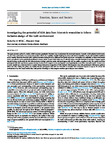Investigating the potential of EDA data from biometric wearables to inform inclusive design of the built environment
| dc.contributor.author | Willis, Katharine S. | |
| dc.contributor.author | Cross, E | |
| dc.date.accessioned | 2022-10-28T10:11:29Z | |
| dc.date.available | 2022-10-28T10:11:29Z | |
| dc.date.issued | 2022-11 | |
| dc.identifier.issn | 1878-0040 | |
| dc.identifier.issn | 1878-0040 | |
| dc.identifier.other | 100906 | |
| dc.identifier.uri | http://hdl.handle.net/10026.1/19770 | |
| dc.description.abstract |
This paper presents a pilot of a method which measures quantitative biometric data to understand the emotional response of people to their physical environment. The aim of the audit method is to address the problem of lack of accessibility of public buildings for those with hidden disabilities. People with invisible disabilities such as Autistic Spectrum Disorders (ASD, Autism) sometimes feeling forced to withdraw from public spaces and communities and unfamiliar or busy environments such as art galleries can be particularly problematic (Amaze, 2018). As part of the Audit, data is collected using a wearable biometric device that is mapped against internal location. In this study the EDA (Electrodermal Activity) Audit was trialed with participants with ASD at a public art gallery in UK. The results reveal that participants with ASD experienced a greater increase in stress level compared to the neurotypical control participants. Areas where noticeable ‘peaks’ of stress were recorded usually had a restricted view or required human interaction. Comparison of GSR (Galvanic Skin Response) data with questionnaire information gathered before and after visiting the gallery also implies that the participants with ASD were less able to articulate their emotional response to spaces. We discuss the development of an EDA Audit method that could provide knowledge to help designers envision spaces that are more inclusive. | |
| dc.format.extent | 100906-100906 | |
| dc.language | en | |
| dc.language.iso | en | |
| dc.publisher | Elsevier | |
| dc.subject | Intellectual and Developmental Disabilities (IDD) | |
| dc.subject | Mental Health | |
| dc.subject | Brain Disorders | |
| dc.subject | Autism | |
| dc.subject | Mental health | |
| dc.subject | 4 Quality Education | |
| dc.title | Investigating the potential of EDA data from biometric wearables to inform inclusive design of the built environment | |
| dc.type | journal-article | |
| dc.type | Journal Article | |
| plymouth.author-url | https://www.webofscience.com/api/gateway?GWVersion=2&SrcApp=PARTNER_APP&SrcAuth=LinksAMR&KeyUT=WOS:000848153200002&DestLinkType=FullRecord&DestApp=ALL_WOS&UsrCustomerID=11bb513d99f797142bcfeffcc58ea008 | |
| plymouth.volume | 45 | |
| plymouth.publication-status | Published | |
| plymouth.journal | Emotion, Space and Society | |
| dc.identifier.doi | 10.1016/j.emospa.2022.100906 | |
| plymouth.organisational-group | /Plymouth | |
| plymouth.organisational-group | /Plymouth/Admin Group - REF | |
| plymouth.organisational-group | /Plymouth/Admin Group - REF/REF Admin Group - FoAH | |
| plymouth.organisational-group | /Plymouth/Faculty of Arts, Humanities and Business | |
| plymouth.organisational-group | /Plymouth/Faculty of Arts, Humanities and Business/School of Art, Design and Architecture | |
| plymouth.organisational-group | /Plymouth/REF 2021 Researchers by UoA | |
| plymouth.organisational-group | /Plymouth/REF 2021 Researchers by UoA/UoA13 Architecture, Built Environment and Planning | |
| plymouth.organisational-group | /Plymouth/Users by role | |
| plymouth.organisational-group | /Plymouth/Users by role/Academics | |
| plymouth.organisational-group | /Plymouth/Users by role/Researchers in ResearchFish submission | |
| dcterms.dateAccepted | 2022-06-13 | |
| dc.rights.embargodate | 2022-10-29 | |
| dc.identifier.eissn | 1878-0040 | |
| dc.rights.embargoperiod | Not known | |
| rioxxterms.versionofrecord | 10.1016/j.emospa.2022.100906 | |
| rioxxterms.licenseref.uri | http://www.rioxx.net/licenses/all-rights-reserved | |
| rioxxterms.type | Journal Article/Review |


